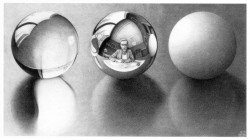Three Spheres of Attraction
Originally published at How to Crush Without Being Crushed. You can comment here or there.

When it comes to relationships, there are many things that can attract us to someone else. All of those things can be sorted into three distinct groups, or spheres. Some may fall into more than one, for we are complex creatures and our relationships reflect that, but that just gives us more ways of working with the situation to make it as positive as possible.
The three spheres of attraction in a relationship are: Mind, Body, and Spirit.
Mind
This sphere of attraction is all in your head-literally. This is cognitive attraction, the kind of attraction to someone you can reason out, point to examples, and clearly say, “This is why I like them!”
The mind sphere of attraction focuses on things that can be measured: Are they a good provider? Will they help you attain things you want in life? Socially and politically, does this make sense?
Not the most romantic of the spheres, but for some people, it’s the most important one. For others, it’s most certainly not.
Relationships built primarily on the questions and answers of the mind sphere of attraction can be very beneficial to both parties and very long-lasting. At least until conditions or needs change. The good news is, when a mind sphere centric relationship ends, the parting is often on good terms (assuming one party wasn’t taking advantage of the other or manipulating them).
This sphere is where our habits reside, for better or worse, and often the one that can become the most twisted and problematic due to various traumas.
Body
The body sphere of attraction is all about biology. Hormones, brain chemistry, pure physical attraction. Before our minds developed and we were little more than kind of advanced animals, this sphere was the driving force behind our attractions and relationships.
You can still see it solidly at work among teenagers… and some people who are older than that, too.
Body sphere centered relationships can be shallow, but active (in many ways). Strength, physical stature, and general health come into play heavily. All parties involved may have a good time, but there is some question to how solid a long-term relationship built mostly on physical preferences will last.
This sphere is where our lust, competitive nature, and drive to reproduce comes from. With age, injury, or health, it can be severely limited. Problems with the body can often spill over into the other spheres, so it’s important to not ignore the needs of the body sphere, no matter how crude or base they may seem.
Spirit
Of all the spheres, the spirit sphere of attraction is the most difficult to grasp at times. This is the home of romance and a passion that doesn’t always make sense when looked at objectively. It’s also where you find those odd connections that draw otherwise very mismatched people together into friendships.
This is the sort of attraction that just kind of happens. There’s not always a clear link to what you find physically attractive or what would be beneficial socially. Still, there’s some sort of draw and connection.
Spirit centered relationships aren’t always romantic ones. In fact, very often we stumble into spirit based relationships because someone catches our attention in a non-romantic, yet not unpleasant, way. Very strong platonic relationships can be built within the sphere of spirit, but the longest lasting and most rich romantic ones are also centered here.
Of course, this is also where some very problematic relationships can grow from-people aren’t always brought into our lives to make them more pleasant, but to help us learn about ourselves. The people that we’re drawn to by some sort of spiritual connection may enter our lives to teach us hard, and unpleasant, lessons… like how we need to stand up for ourselves or be walked all over, or how to deal with the sudden loss of a loved one.
Three Facets of Each
Each of those three spheres of attraction have three facets to them: Objective (what anyone can see and agree on), Projected (what we want to see, but isn’t necessarily so), and Actual (what actually is).
When trying to make sense of a relationship, it’s important to take into account each of these facets.
We may be drawn to someone in a physical way, but project upon them some great spiritual significance because, in our minds, we think we should only be attracted to someone in more “pure” ways. Alternately, we could spend a lot of time and energy rationalizing ourselves out of a relationship because we don’t think it’s a good idea, but our spiritual sphere tells us otherwise.
Straightening out which sphere and which facet is influencing us at any given time is one of the more difficult things to keep track of. Because of that, it’s of the utmost importance to have someone (preferably a few people) to talk to about your thoughts and feelings. Bringing in more solidly objective and actual facets helps us clear up what we’re projecting and reconcile any disparities among our three spheres of attraction.
Which sphere do you think you’re most prone to be lead by when finding someone attractive? How has following that attraction worked out for you?